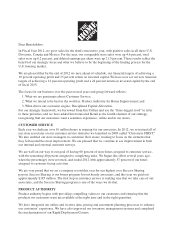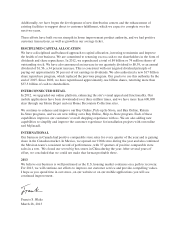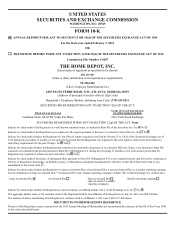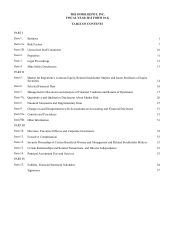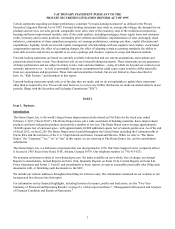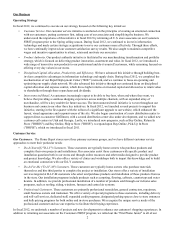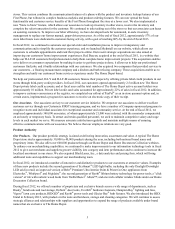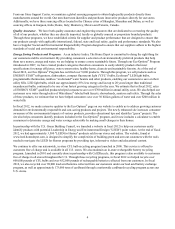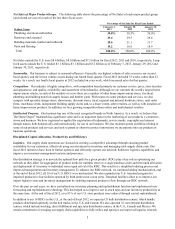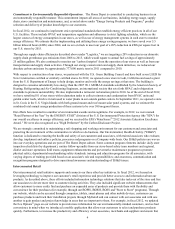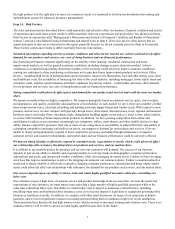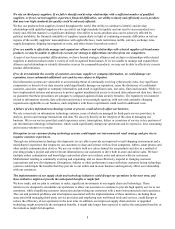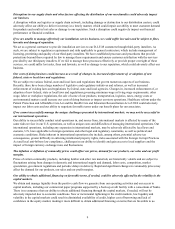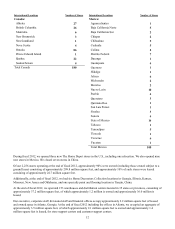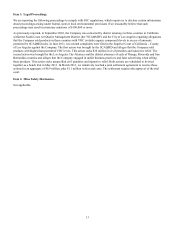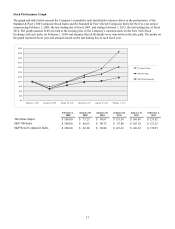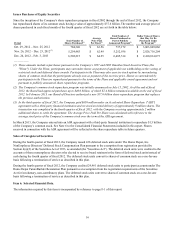Home Depot 2012 Annual Report Download - page 13
Download and view the complete annual report
Please find page 13 of the 2012 Home Depot annual report below. You can navigate through the pages in the report by either clicking on the pages listed below, or by using the keyword search tool below to find specific information within the annual report.
7
the right product is in the right place to meet our customers' needs, we continued to develop our distribution forecasting and
replenishment system for enhanced inventory management.
Item 1A. Risk Factors.
The risks and uncertainties described below could materially and adversely affect our business, financial condition and results
of operations and could cause actual results to differ materially from our expectations and projections. You should read these
Risk Factors in conjunction with "Management’s Discussion and Analysis of Financial Condition and Results of Operations"
in Item 7 and our Consolidated Financial Statements and related notes in Item 8. There also may be other factors that we
cannot anticipate or that are not described in this report generally because we do not currently perceive them to be material.
Those factors could cause results to differ materially from our expectations.
Sustained uncertainty regarding current economic conditions and other factors beyond our control could adversely affect
demand for our products and services, our costs of doing business and our financial performance.
Our financial performance depends significantly on the stability of the housing, residential construction and home
improvement markets, as well as general economic conditions, including changes in gross domestic product. Adverse
conditions in or sustained uncertainty about these markets or the economy could adversely impact consumer confidence,
causing our customers to delay purchasing or determine not to purchase home improvement products and services. Other
factors – including high levels of unemployment and foreclosures, interest rate fluctuations, fuel and other energy costs, labor
and healthcare costs, the availability of financing, the state of the credit markets, including mortgages, home equity loans and
consumer credit, weather, natural disasters and other conditions beyond our control – could further adversely affect demand
for our products and services, our costs of doing business and our financial performance.
Strong competition could adversely affect prices and demand for our products and services and could decrease our market
share.
We operate in markets that are highly competitive. We compete principally based on customer service, price, store location
and appearance, and quality, availability and assortment of merchandise. In each market we serve, there are a number of other
home improvement stores, electrical, plumbing and building materials supply houses and lumber yards. With respect to some
products and services, we also compete with specialty design stores, showrooms, discount stores, local, regional and national
hardware stores, mail order firms, warehouse clubs, independent building supply stores and, to a lesser extent, other retailers,
as well as with installers of home improvement products. In addition, we face growing competition from online and
multichannel retailers as our customers increasingly use computers, tablets, smart phones and other mobile devices to shop
online. Intense competitive pressures from one or more of our competitors or our inability to adapt effectively and quickly to
a changing competitive landscape could affect our prices, our margins or demand for our products and services. If we are
unable to timely and appropriately respond to these competitive pressures, including through maintenance of superior
customer service and customer relationships, our market share and our financial performance could be adversely affected.
We may not timely identify or effectively respond to consumer needs, expectations or trends, which could adversely affect
our relationship with customers, the demand for our products and services, and our market share.
It is difficult to successfully predict the products and services our customers will demand. The success of our business
depends in part on our ability to identify and respond promptly to evolving trends in demographics, consumer preferences,
expectations and needs, and unexpected weather conditions, while also managing inventory levels. Further, we have an aging
store base that requires maintenance to deliver the shopping environment our customers desire. Failure to maintain attractive
stores and to timely identify or effectively respond to changing consumer preferences, expectations and home improvement
needs could adversely affect our relationship with customers, the demand for our products and services, and our market share.
Our success depends upon our ability to attract, train and retain highly qualified associates while also controlling our
labor costs.
Our customers expect a high level of customer service and product knowledge from our associates. To meet the needs and
expectations of our customers, we must attract, train and retain a large number of highly qualified associates while at the
same time controlling labor costs. Our ability to control labor costs is subject to numerous external factors, including
prevailing wage rates and health and other insurance costs, as well as the impact of legislation or regulations governing labor
relations or healthcare benefits. In addition, we compete with other retail businesses for many of our associates in hourly
positions, and we invest significant resources in training and motivating them to maintain a high level of job satisfaction.
These positions have historically had high turnover rates, which can lead to increased training and retention costs. There is no
assurance that we will be able to attract or retain highly qualified associates in the future.


